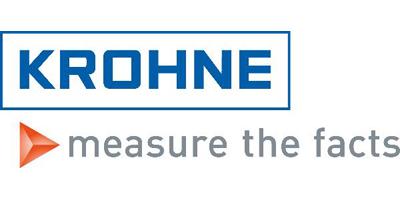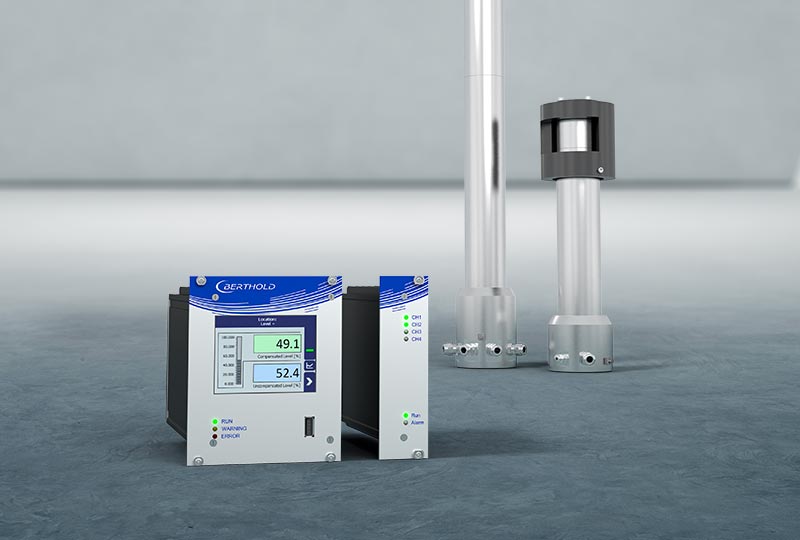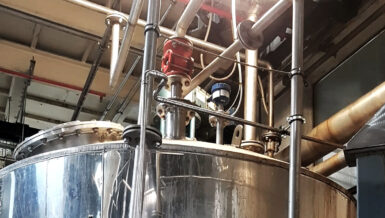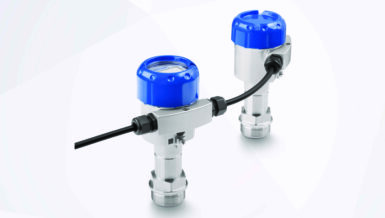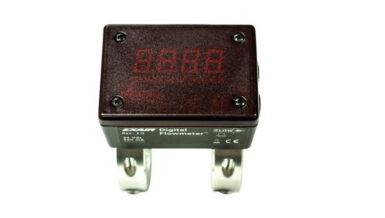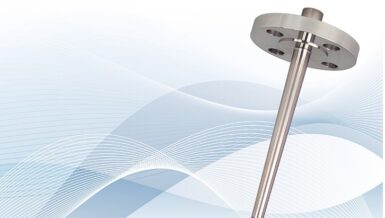The major benefit is the contactless measurement principle, which is based on time-of-flight echo measurements in the free space above the filling medium by using microwaves. This allows for reliable measurements under various practical conditions and also with aggressive media like acids and bases. Microwaves easily propagate through dust and mist in the air, and the propagation speed is largely constant and independent of the composition of the air and of parameters like pressure, temperature, and others. Accordingly, radar systems also allow for accurate level measurements in the case of ‘dirty’ applications, even if the radar antenna is for example covered by bulk solid material, condensed water, etc.


In the field of radar level measurement systems, mainly two different concepts are utilised: The so-called Frequency-Modulated Continuous-Wave (FMCW) radars and pulse radars. As will be discussed in this whitepaper, FMCW radars have many advantages against others, whereby the large measurement sensitivity (dynamic range) is the most important feature. This is the motivation for KROHNE to exclusively use the FMCW concept as the basis for the design and engineering of all OPTIWAVE radar level measurement systems. This applies from starting with its first generation, which was available in the market in the year 1989 (BM 70), up to the very latest versions of today!
It will be shown below that the characteristics of any radar system (beam width, range resolution, echo signal amplitude, etc.) and, accordingly, the radar level measurement performance (measurement sensitivity, ability to distinguish different radar targets from each other, measurement accuracy, etc.) depend on various parameters of the radar system. Among these parameters, the utilised frequency band, and more precisely the centre frequency and the bandwidth, and the size (diameter) of the utilised radar antenna is the most important.
For this reason, radar systems are working in different frequency bands and also various types of radar antennas of different sizes are available to fulfill the individual requirements in different applications under different process conditions. Diverse aspects have to be taken into consideration to allow for a suitable and proper selection of an optimum radar system and antenna combination. It is the focus of this whitepaper to give some according to hints. In the case of need for additional information, the KROHNE application specialists are very willing to help and to give any kind of support to our valued customers.
FMCW radar systems
Radar level measurement is generally based on emitting microwaves from the radar antenna, receiving the microwaves, which are reflected at the liquid’s surface or which are backscattered from the bulk solid heap and propagate back to the radar, and to measure the round-trip time-of-flight. In pulse radar systems, this is achieved by emitting a short pulse signal with a small duration and directly acquiring the resulting echo signal. For the latter usually, a sequential sampling technique is employed, i. e. no single pulse is emitted but a sequence of periodically repeated pulses, and the echo signal is sampled using a second sequence of pulses with a slightly different repetition time period. The energy of each transmitted pulse is relatively small because the peak amplitude is very limited. Along with the sequential sampling, this generally results in a relatively small dynamic range of pulse radars and a relatively bad signal-to-noise ratio (SNR).
The concept of FMCW radar systems is completely different in order to achieve a much better SNR. A continuous-wave signal is generated and emitted, i. e. a signal with a very large temporal duration and, accordingly, with much larger energy as compared to the emitted signal of a pulse radar system (even in the case of the same peak amplitude). The frequency of the continuous-wave signal is linearly modulated over time (linear ‘frequency sweep’), starting from the desired lower corner frequency up to the higher corner frequency (or vice versa) covering the required frequency band. Advantageously with this approach, the ‘sweep duration can be chosen independently from the bandwidth, the signal can simply be generated by means of a voltage-controlled oscillator (VCO), and the spectral purity of the signal is very high. The latter enables easily to avoid non-intended emissions in adjacent frequency bands and to fulfill the given radio regulations.


The approach for processing the echo (which is also a continuous- wave signal) in an FMCW radar system is to mix (multiply) the received signal with the transmit signal. After subsequent low-pass filtering, a low-frequency signal (the so-called intermediate-frequency signal) is directly obtained. As another advantage of the FMCW concept, this signal can directly be digitised using a low-cost analog-to-digital converter (ADC) (with a low sampling frequency) and no sequential sampling has to be performed.
In the past, however, the challenge was to accurately generate a high linear frequency sweep. KROHNE was already very early able to guarantee this requirement in the OPTIWAVE series radar level measurement systems, handling also the strong restrictions regarding limited supply power given by two-wire devices. This was achieved by employing the latest state-of-the-art in the field of phase-locked loop (PLL) technology for stabilising and controlling the FMCW signal.
With the more recent advances in the technological field of monolithic microwave integrated circuits (MMIC) and with the much better availability of MMICs, the majority of industrial manufacturers and suppliers of radar level measurement systems now also move from pulse radar systems to the FMCW radar technology (at least in their latest systems). Besides this trend, which is motivated by the largely improved performance of the FMCW concept, a large variety of pulse radars is still available in the market. As already mentioned above, the FMCW concept has exclusively been used as the basis for all KROHNE radar level measurement systems.
Radar system parameters
Each combination of a radar level measurement system and an antenna is characterised by a set of technical parameters as follows:
- Utilised frequency band (centre frequency and bandwidth)
- Antenna size (diameter and length)
- Type of antenna (horn antenna, dielectric ‘drop’ antenna, dielectric lens antenna)
- Antenna gain and efficiency
The angular beamwidth of the antenna radiation field is inversely proportional to the aperture diameter of the antenna and to the centre frequency. Accordingly, the beamwidth decreases with increasing centre frequency in the case that the diameter of the antenna is kept constant. Furthermore, in the case of keeping the frequency constant, the beam width also decreases with the increasing diameter of the antenna. In conclusion, the beam width does not simply depend on one single parameter, but both parameters centre frequency and antenna diameter are degrees of freedom for determining the angular beamwidth. The choice of one specific antenna from a set of available antennas with different beam widths has to be made dependent on the given application conditions.

On the one hand, the angular beamwidth has preferably to be small in the case of huge narrow tanks or silos in order to avoid the unwanted ‘illumination’ of the tank or silo wall or to avoid any disturbing echo signal from tank internals (e.g. agitators or reinforcement structures). On the other hand, the beam width should not be too small, for example, if movements (‘waves’) are given on the liquid surface or if a perpendicular incident direction towards the planar surface of the liquid cannot be guaranteed. The latter might be the case, for example, if the flange on a given tank is not perfectly horizontal. In either of these scenarios, the reflected microwaves would not arrive back at the radar if the angular beamwidth is too small and consequently no echo would be detected by the radar.

The transmission loss is the ratio between the transmitted power and the received power, and this parameter is largely dependent on the properties of the antenna (gain and efficiency), the utilised frequency, and also of course, on the reflection or backscattering properties of the liquid or bulk solid respectively. While the reflection coefficient of the planar liquid surface does not change with frequency, the backscattering at fine granulated bulk solids largely increases with increasing frequency. Accordingly, the penetration of microwaves into the bulk solid heap decreases.
As a general rule of thumb, the received power generally increases with increasing frequency and with increasing the diameter of the antenna. For this reason, the echo signal level can generally be increased by using a high frequency and an antenna with a large diameter.
Taking the above-discussed relationships for the angular beamwidth into consideration, it is obvious that the maximization of both parameters frequency and antenna diameter for minimising the transmission loss leads at the same time to a minimum beamwidth of the antenna.

At first glance, it looks advantageous to always configure a radar system for minimum transmission loss and minimum beam width, but there are exceptions. Also in the above-discussed scenarios (‘waves’ on top of the liquid, no horizontal flange), where a too-small angular beam width is not applicable (what is usually a more special case), it is not feasible to maximise both parameters centre frequency and diameter, but only one of them.
Furthermore, in other more special scenarios, for example with some foam given on the surface of the liquid, it is not a good choice to maximise the frequency.
The range resolution, which is another interesting parameter of the radar system, describes its ability to separate different radar targets from each other over distance, and this parameter is inversely proportional to the bandwidth. For this reason, a large bandwidth is required to allow a good separation between echoes from the filling medium and from other ‘disturbing’ objects like the antenna outlet reflection (being the root cause for the so-called ‘upper dead zone’) or, for example, weld seams in the tank or silo wall. Typically, the bandwidth of a radar system is proportionally increasing with its centre frequency.
Besides technical restrictions regarding the utilised bandwidth of a radar system, special frequency bands in the 6 GHz range (C-band), 10 GHz range (X-band), 24 GHz range (K-band), and 80 GHz range (W-band) have been designated to industrial radar systems in the framework of the worldwide harmonization of radio frequencies. Radio regulations distinguish between ‘tank level probing radar’ (TLPR) inside closed metallic tanks or silos and ‘level probing radar’ (LPR) outside with larger restrictions.
Radar antennas
A variety of radar antennas based on different concepts and designs are available to cover the individual demands in different applications. Furthermore, also the utilised frequency band has some impact on the type of antenna used:

This type of antenna is available for the 80 GHz frequency range radar systems. Here, a dielectric lens is given at the interface between the radar and the tank or silo and can directly fulfill the function of a ‘barrier element’. Advantageously with this design, the overall length of the antenna is very small, while offering a good electrical matching.
This is the standard type of antenna, especially for the 10 GHz and 24 GHz frequency ranges, and horn antennas usually have very good applicability in most applications. The overall length of horn antennas is relatively large, but they provide a very good electrical matching to the free space. Additionally, antenna waveguide feeds including a so-called ‘metaglass’ or plastic component are available as a ‘barrier element’ between the tank or silo and the environment. This is relevant for means of explosion protection if an inflammable or explosive atmosphere is given inside the tank or silo.


This type of antenna has been specially designed and optimised for offering a smaller overall length with the same (and even better) performance as a horn antenna of the same diameter and for directly functioning as a ‘barrier element’. Furthermore, the ‘drop’ antenna is the perfect choice for bulk solid applications and ‘dirty’ environments, because adherences of bulk solid material, condensed water, etc. are largely avoided by the smooth surface of the antenna. Also, adherences are generally less critical with the volumetric plastic body of the antenna. The ‘drop’ antenna shows a good electrical matching and is available for the 24 GHz frequency range.
The overall length of the antenna is especially interesting with regard to the decay of disturbing echoes (‘antenna ringing’) over distance, which results from multiple reflections inside the antenna caused by the (always given) mismatching at the front face of the antenna and at its feeding point. This decay is faster the smaller the overall length of the antenna is. Accordingly, a short antenna is very favourable if level measurements should also be done at very small distances, i. e. close to the antenna.
Summary and conclusions
Following the above-mentioned discussions and explanations, it becomes obvious that the answer to all challenging level measurement applications could not be given by only one radar system. The solution is always the proper selection of the radar system and the antenna combination, dedicated to the specific application.
Therefore, a complete range of FMCW radar systems and a large variety of corresponding antennas is the real enabler to provide solutions for contactless level measurement for nearly every application.




